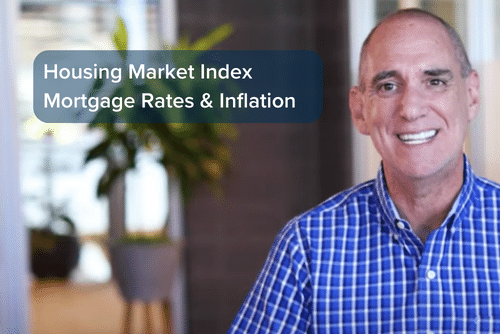Once a month, Matthew Gardner, Windermere Real Estate’s Chief Economist, provides insights on our housing market. We’ve listed some of his recent predictions, thoughts, and conclusions to give you the information you need to make well-informed real estate decisions. And, you can also watch Gardner’s full videos below to learn even more.
The Continued Decline of the Housing Market Index
The National Association of Home Builders released their Housing Market Index for August, and the data was “eye-opening” as Matthew Gardner says. Based on a survey of home builders, this index asks them to give their take on the single-family market. Builder confidence fell for the 8th straight month, dropping below the index level of 50. As Gardner explains, “More home builders currently rate sales conditions as poor than good…Builders have been reporting a spike in canceled contracts recently.” Additionally, all components of the Housing Market Index are at their lowest level since May of 2020. 69% say mortgage rates are the primary reason, and 19% of builders have reduced prices in an effort to increase sales. Gardner says he uses the Housing Market Index as a reliable indicator when it comes to single-family housing starts.
When it comes to new homes for sale, there’s a rise in listings of 32.1% year-over-year. Furthermore, of the homes currently for sale, 67% are under construction. 24% haven’t broken ground yet, and 9% are ready for new owners to occupy them. While it may seem like it isn’t that bad since only 9% are finished, Gardner points out that “builders incur costs every day that the home is not sold, even if that home has yet to be built.”
“With more homes for sale and lower transactions, it would now take more than 9 months to absorb all available homes using the current sales pace.” As a result, new home starts fell by 10.1% between June and July of this year. And, starts have dropped by 18.5% from a year ago.
Affordability is a key issue that Gardner highlights. He also points out how construction costs have impacted builders. And, that is magnified by the fact that they’re competing with rising inventory in the resale market. “Last month, the average price drop was 5% but this is very likely to increase as we move toward the fall.”
To learn more, watch the full video below.
Mortgage Rates and Inflation
In the beginning of 2022, 30-year conventional mortgage rates started at just over 3.1% but have skyrocketed to 6%. While economists like Matthew Gardner expected rates to trend higher this year, no one anticipated such a dramatic increase. That’s because no one could’ve factored in Russia’s invasion of Ukraine and that inflation would continue to climb for much longer than we expected. As a result, “when inflation is running hot, it limits demand for bonds,” Gardner explains. This then “forces the interest rate payable on those bonds to rise and this pushes mortgage rates higher.”
Gardner also looks at other inflation indicators, which point to the fact that slower spending acts as a headwind to further price increases. He also looks at the Producer Price Index, which measures at the wholesale level, not the retail level. “Even though the total rate rose as energy costs continue to impact the manufacturing sector, the core rate has been pulling back again for the past three months.”
Matthew Gardner concludes, “If the trends we’ve looked at continue, I still expect inflation to start slowly creeping lower, which will push bond prices higher, yields will start to, if not drop, then certainly pause. That will allow mortgage rates to hold at – or close to – their current levels for the time being. But we could actually see rates coming down a little.”
You can watch more of Gardner’s videos on Windermere’s YouTube channel. If you have any questions about the information we’ve shared, feel free to reach out to one of our local real estate experts. Our agents are highly knowledgeable and happy to assist you.
 Facebook
Facebook
 X
X
 Pinterest
Pinterest
 Copy Link
Copy Link
